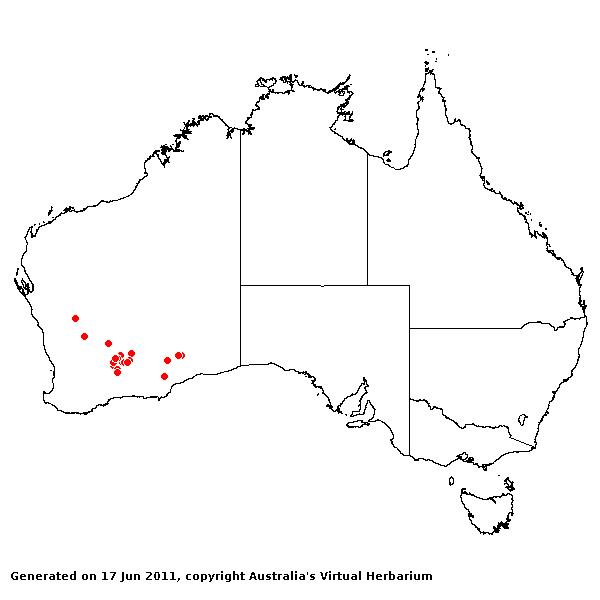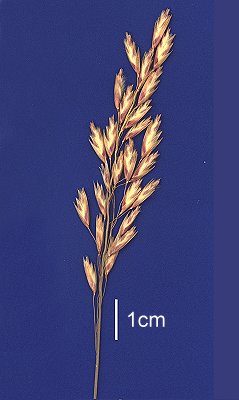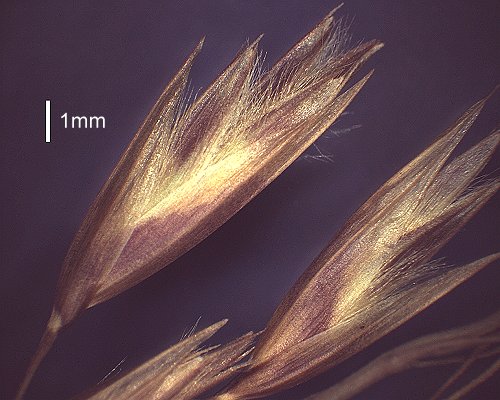Triodia tomentosa
S.W.L. Jacobs. Telopea 4: 655 (1992).
Classification. (GPWG 2001) : Subfamily Chloridoideae. Triodeae.
Type of Basionym or
Protologue Information: Western Australia: Eremaean Province; Great
Northern Highway, 29º18' S, 117º36' E, 24 Oct 1984, M.G. Corrick 9324
(HT: NSW; IT: MEL).
Key references
(books and floras): [2002] D.Sharp & B.K.Simon, AusGrass, Grasses of
Australia.
Habit.
Perennial. Culms 45–90 cm tall. Leaf-sheaths smooth or scaberulous, glabrous on
surface or hairy. Leaf-sheath auricles absent. Ligule a fringe of hairs, 1–1.5
mm long. Leaf-blades filiform, conduplicate, 8–28 cm long, 0.7–1 mm wide.
Leaf-blade surface scabrous, glabrous.
Inflorescence.
Inflorescence compound, a panicle. Panicle ovate, 9–15 cm long, 2.5–4 cm wide.
Spikelets.
Spikelets pedicelled. Fertile spikelets many flowered, with at least 2 fertile
florets (4–7), comprising 4–7 fertile floret(s), with diminished florets at the
apex, linear or lanceolate or cuneate, laterally compressed, 8–14 mm long.
Rhachilla internodes elongated between glumes.
Glumes.
Glumes similar, thinner than fertile lemma. Lower glume lanceolate, scarious,
keeled, 1-keeled, 1–3(–5) -nerved. Lower glume surface glabrous or indumented.
Lower glume apex muticous or mucronate. Upper glume lanceolate, 7–13 mm long,
scarious, keeled, 1-keeled, 1–3(–5) -nerved. Upper glume surface smooth or
asperulous, glabrous or indumented. Upper glume apex entire, muticous or
mucronate.
Florets.
Fertile lemma 7.5–10 mm long, without keel, 3 -nerved or 9 -nerved. Lemma
surface indumented. Lemma apex dentate or lobed, muticous or mucronate. Median
(principal) awn from a sinus. Lodicules present. Anthers 3. Grain 2.5 mm long.
Continental
Distribution: Australasia.
Australian
Distribution: Western Australia.
Western Australia:
Austin. Eucla, Roe, Coolgardie.
Notes.
Distinguished by the dense, woolly and tangled hairs on the sheaths, orifice
and lower part of the blades; the loose paniculate inflorescence; scarious,
glabrous glumes long relative to the spikelet; mostly hirsute, minutely lobed
lemmas; bitextured lemma and palea; loose florets; relatively long, entirely
hairy callus; long ligule.
Similar to T. lanata, but differs by
its glabrous glumes.
Currently
known from the Eremaean Province, W.A., between 27°S and 33°S, and 117°E and
125°E. Recorded on flats, plains and gentle slopes in red sandy gravelly soils
over limestone and laterite, or with granite outcrops; flowers July-Nov.




